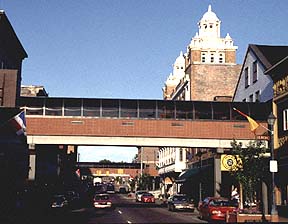| Physical Strategies | Functional Strategies |
|---|
Minneapolis/St. Paul:
Skywalk System
Skywalks are glass enclosed pedestrian bridges linking buildings at the second floor level. Minneapolis started building skywalks in 1962 and today their extensive system of walkways is over five miles in length, connecting over fifty downtown blocks of stores, offices, theatres, restaurants, Target Center and the convention center. Built to provide an easy connection from parking structures to downtown shops and offices, they also provide protection from the elements. The skywalks in Minneapolis are privately built and maintained, this is one of the reasons for their many different designs. In other cities, skywalks are publicly owned and financed. As downtown development has increased in Minneapolis, so has the network of skywalks. New retail shops, restaurants and hotels have created a second-level city. Building owners can charge a lease premium for these second-level locations linked by the walkways.

Critics of skywalks maintain that their proliferation has reduced street level activity. Businesses located on the street level have closed due to lack of pedestrian traffic and property values have declined.1 This lack of street level pedestrians and activities creates the perception of an inactive and dull downtown. Some city planners feel that street level retail shops are the key to a vital and multi-use downtown.2 Critics are also concerned with the privatization of these public spaces and a separation of people based on class. Many of the skywalks link upscale hotels, shops and professional offices signaling to many low and moderate income people that they are not welcome.
Cities with historic downtown structures have seen these building facades obliterated by modern skywalks and street vistas blocked. The ability to gaze down a street is an important means of orienting oneself in the city. Many are disturbed by this destruction of street level building views.3However, it is hard to ignore the economic revitalization that has occurred in cities with downtown skywalks.
References
1
Robertson, Kent A. Pedestrianization Strategies for Downtown Planners. Journal of the American Planning Association, Vol. 59, No. 3, Summer 1993.2
Andersen, Kurt. Fast Life Along the Skywalks. Time , August 1, 1988.3
Design Quarterly, No. 129. 1985.
Page Author: Laurie Yorke
| Physical Strategies | Functional Strategies |
|---|
.
